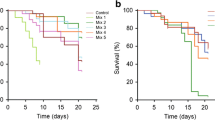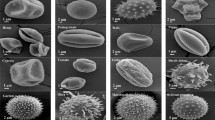Abstract
Laboratory trials were performed at 27 °C on micro-colonies comprised of three Bombus terrestris workers. They were fed with syrup and pollen paste ad libitum. The micro-colonies were terminated on the 14th day after egg-laying. Two bioassays tested the nutritive value of 6 pure pollens and 9 commercial pollen mixes on bumblebee larvae. Among 10 criteria tested, the most sensitive to the different pollens were the mean weight of larvae and the rate of discarded larvae. Differentiation between treatments was easier with single pollens that ranged from 14.4% to 24.9% crude protein for Helianthus and Castanea respectively, than with mixes that ranged from 12.9% to 17.6%. The best performance ranking was assigned to Castanea, Papaver and Rubus, which produced larvae weighing 110–150 mg, the lowest to Helianthus and Cistus which resulted in larvae of 20–50 mg. The largest larvae (240 mg) were produced with the mix at 96% Brassica and 15.9% protein and the smallest with the mix at the lowest protein content (12.9%) assembling Picris, Hedera, Amaranthus, Solanum, Helianthus and graminaceae.
Zusammenfassung
Der Nährwert von Pollen, der von Honigbienen gesammelt wurde, stellt einen Schlüsselfaktor für die kommerzielle Hummelzucht dar. Wir wollten eine einfache, schnelle und empfindliche Methode entwickeln, mit der man routinemäßig den Nährwert verschiedener Pollen vergleichen kann. Die Ziele unserer Studie waren: (i) Ein Vergleich der Empfindlichkeit der vorhandenen Kriterien zum Test der Nährwerte von Pollen bei der Produktion von Larven in weisellosen Mikro-Völkern mit Arbeiterinnen; (ii) Ein Test der Qualität von 6 Pollen, die zu verschiedenen Pflanzenfamilien gehören und von 9 kommerziellen Pollengemischen, die derzeit von Hummelzüchtern benützt werden.
Für die Tests wurden Mikro-Völker mit drei Bombus terrestris Arbeiterinnen in kleinen Kästen (11 × 5 × 5 cm) benutzt, die bei 27 °C, 70 % RF und einem Dunkel-Licht-Rhythmus von D8 : L16 gehalten wurden. Pollen und Zuckerwasser wurden ad libitum angeboten. Der Pollen wurde als Paste in 1–2g-Bällchen angeboten. Neun Diäten mit kommerziellen Pollengemischen, die aus Honigbienenvölkern gesammelt wurden und 6 Diäten mit nur einer Pollensorte wurden den Mikro-Völkern gefüttert und die Versuche 10 bis 13 mal wiederholt. Die Hauptpollen in den Gemischen waren: Salix, textit-Picris, Brassica, Prunus, Quercus (Tab. I).
Einzelpollen waren: Castanea, Actinidia, Cistus, Papaver, Helianthus und Rubus. Über folgende Kriterien wurde der Nährwert bestimmt: (i) Eiweißgehalt anhand der Stickstoff-Bestimmung, (ii) Anzahl und Größe der Larven (Gewicht der Larven pro Mikro-Volk, mittleres Gewicht der Larven), (iii) Verluste (Arbeiterinnenmortalität, ausgeräumte Larven, Oophagie und Zerstörung von Eizellen), (iv) Pollenaufnahme und Effektivität der Pollenverwendung (Pollenaufnahme durch Arbeiterinnen während der 5 Tage vor Eiablage, Pollenaufnahme während der 14 Tage nach Eiablage, Polleneffektivität, Eiweißeffektivität). Die Pollen- und Eiweißeffektivität wurden durch den Quotienten „Gewicht der produzierten lebenden Larve / Pollen- bzw. Eiweißaufnahme“ bestimmt.
Zwei aus Einzelpollen gebildete Pasten wiesen den höchsten Stickstoffgehalt auf: Papaver (3,98 %) und Castanea (3,25 %). Pasten aus Cistus und Helianthus (2,31 % und 2,30 %) hatten den geringsten Gehalt, während Rubus (3,08 %) und Actinidia (2,91 %) dazwischen lagen. Der Stickstoffgehalt von gemischten Pasten reichte von 2,06 % für Mix B, bis 2,82 % für Mix G. (Tabs. II und III).
Castanea, Papaver und Rubus produzierten die größten Larven (0,15 g, 0,12 g and 0,11 g), während Actinidia, Cistus und Helianthus die kleinsten hervorbrachte (0,09 g, 0,05 g bzw. 0,02). Die höchsten Larvenausräumraten wurden bei Fütterung mit Papaver (27 %) und Helianthus (22,4 %) beobachtet, die geringsten bei Fütterung mit Castanea (4,5 %) und Rubus (6 %). Darüber hinaus gab es bei 4 weiteren Kriterien Unterschiede (Tab. IV).
Bezüglich einiger der 9 Mischungen traten nur bei drei Parametern Unterschiede auf: durchschnittliches Larvengewicht, Entfernen von Larven und Futterverbrauch durch die Arbeiterinnen. Obwohl keine klare Rangordnung bezüglich der Qualität der Mischungen aufgestellt werden konnte, scheint es, dass Mischungen mit hohem Anteil an Picris oder Quercus einen Effekt auf die Larven haben (Tab. V). Die wichtigsten Parameter in einem solchen Bruttest sind das durchschnittliche Larvengewicht und die Ausräumrate der Larven 14 Tage nach Eiablage. Einzelpollen sind leichter zu vergleichen als Mischungen. Pollen von Compositae ist von eindeutig schlechter Qualität. Es muss geprüft werden, ob Tests in Mikro-Völkern eine Vorhersage bezüglich des Nährwertes von Pollen in weiselrichtigen Völkern erlauben.
Similar content being viewed by others
References
Campana B.J., Moeller F.E. (1977) Honeybees: preference for and nutritive value of pollen from five plant sources, J. Econ. Entomol. 70, 39–41.
Cremonez T.M., Jong D. De, Bitondi M.M.G. (1998) Quantification of haemolymph proteins as a fast method for testing protein diets for honeybees (Hymenoptera: Apidae), J. Econ. Entomol. 91, 1284–1289.
Duchateau M.J., Velthuis H.H.W. (1989) Ovarian development and egg laying in workers of Bombus terrestris, Entomol. Exp. Appl. 51, 199–213.
Genissel A., Aupinel P., Bressac C., Tasei J.N., Chevrier C. (2002) Influence of pollen origin on performance of Bombus terrestris micro-colonies, Entomol. Exp. Appl. 104, 329–336.
Groot A.P. de (1953) Protein and amino acid requirements of the honeybee (Apis mellifera L.), Physiol. Comp. Oecol. 3, 197–285.
Haydak M.H. (1968) Nutrition des larves d’abeilles, in: R. Chauvin (Ed.), Traité de Biologie de l’Abeille, Vol. 1, Masson et Cie, Paris, pp. 302–333.
Haydak M.H. (1970) Honey bee nutrition, Ann. Rev. Entomol. 15, 143–156.
Herbert E.W., Bickley W.E., Shimanuki H. (1970) The brood-rearing capability of caged honey bees fed dandelion and mixed pollen diets, J. Econ. Entomol. 63, 215–218.
Herbert E.W. Jr., Shimanuki H., Shasha B.S. (1980) Brood rearing and food consumption by honeybee colonies fed pollen substitutes supplemented with starch encapsulated pollen extracts, J. Apic. Res. 19, 115–118.
Hoover S.E.R., Higo H.A., Winston M.L. (2006) Worker honey be ovary development: seasonal variation and the influence of larval and adult nutrition, J. Comp. Physiol. B 176, 55–63.
Jay S.C., Jay D.H. (1993) The effect of kiwifruit (Actinidia deliciosa A Chev) and yellow flowered broom (Cystisus scoparius Link) pollen on the ovary development of worker honeybees (Apis mellifera L), Apidologie 24, 557–563.
Kleinschmidt G.J., Kondos A.C. (1978) The effect of dietary protein on colony performance, Aust. Beekeeper June, 251–257.
Levin M.D., Haydak M.H. (1957) Comparative value of different pollens in the nutrition of Osmia lignaria, Bee World 38, 221–226.
Loper G.M., Berdel R.L. (1980) The effects of nine pollen diets on brood rearing of honeybees, Apidologie 11, 351–359.
Loper G.M., Cohen A.C. (1987) Amino acid of dandelion pollen, a honeybee (Hymenoptera: Apidae) nutritional evaluation, J. Econ. Entomol. 80, 14–17.
McCaughey W.F., Gilliam M., Standifer L.N. (1980) Amino acids and protein adequacy for honeybees of pollens from desert plants and other floral sources, Apidologie 11, 75–86.
Maurizio A., Louveaux J. (1965) Pollens de plantes mellifères d’Europe, Union des Groupements Apicoles Français, Paris.
Nguyen V.N. (1999) Effect of protein nutrition and pollen supplementation of honeybee, Apis mellifera L. colonies on characteristics of drones with particular refernece to sexual maturity, Aust. Beekeeper Mar., 374–376.
Örösi Pal Z. (1968) Physiologie des glandes nourricières, in: R. Chauvin (Ed.), Traité de Biologie de l’Abeille, Vol. 1, Masson et Cie, Paris, pp. 263–290.
Pain J. (1968) Nutrition et développement des organes sexuels adultes, in: R. Chauvin (Ed.), Traité de Biologie de l’Abeille, Vol. 1, Masson et Cie, Paris, pp. 410–435.
Pernal S.F., Currie R.W. (2000) Pollen quality of fresh and 1-year-old single pollen diets for worker honey bees (Apis mellifera L.), Apidologie 3, 387–409.
Pernal S.F., Currie R.W. (2001) The influence of pollen quality on foraging behavior in honeybees (Apis mellifera L.), Behav. Ecol. Sociobiol. 51, 53–68.
Plowright R.C., Pendrel R.A. (1977) Larval growth in bumblebees (Hymenoptera: Apidae), Can. Entomol. 109, 967–973.
Rasheed S.A., Harder L.D. (1997) Economic motivation for plant species preferences of pollen collecting bumblebees, Ecol. Entomol. 22, 209–219.
Regali A., Rasmont P. (1995) Nouvelles méthodes de test pour l’évaluation du régime alimentaire chez des colonies orphelines de Bombus terrestris L. (Hymenoptera: Apidae), Apidologie 26, 273–281.
Ribeiro M. (1994) Growth in bumble bee larvae: relation between development time, mass, and amount of pollen ingested, Can. J. Zool. 72, 1978–1985.
Ribeiro M., Velthuis H.H.W., Duchateau M.J. (1993) Growth in bumblebee larvae: relations between the age of the larvae, their weight and the amount of pollen ingested by them, Proc. Exp. Appl. Entomol. N.E.V. Amsterdam 4, 121–125.
Ribeiro M., Duchateau M.J., Velthuis H.H.W. (1996) Comparison of the effects of two kinds of commercially available pollen on colony development and queen production in the bumblebee Bombus terrestris L. (Hymenoptera: Apidae), Apidologie 27, 133–144.
Roulston T.H., Cane J.H., Buchmann S.L. (2000) What governs protein content of pollen: pollinator preferences, pollen-pistil interactions, or phylogeny? Ecol. Monogr. 70, 617–643.
Roulston T.H., Cane J.H. (2000) Pollen nutritional content and digestibility for animals, Plant Syst. Evol. 222, 187–209.
Roulston T.H., Cane J.H. (2002) The effect of pollen protein concentration on body size in the sweat bee Lasioglossum zephyrum (Hymenoptera: Apiformes), Evol. Ecol. 16, 49–65.
Schmidt L.S., Schmidt J.O., Rao H., WeiYi W., Ligen X. (1995) Feeding preference and survival of young worker honeybees (Hymenoptera: Apidae) fed rape, sesame, and sunflower pollen, J. Econ. Entomol. 88, 1591–1595.
Singh S., Saini K., Jain K.L. (1999) Quantitative comparison of lipids in some pollens and their phagostimulatory effects in honeybees, J. Apic. Res. 38, 87–92.
Stanley R.G., Linskens H.F. (1974) Pollen-Biology Biochemistry Management, Springer-Verlag, Berlin, Heidelberg, New-York.
Sutcliffe G.H., Plowright R.C. (1988) The effects of food supply on adult size in the bumble bee Bombus terricola Kirby (Hymenoptera: Apidae), Can. Entomol. 120, 1051–1058.
Szymas B., Przybyl A. (1996) Physiological condition of worker bees (Apis mellifera L.) after consumption of pollen substitute, Psczczelnicze Zeszyty Naukowe 40, 109–117.
Tasei J.N. (1973) Le comportement de nidification chez Osmia (Osmia) cornuta Latr. et Osmia (Osmia) rufa L. (Hymenoptera: Megachilidae), Apidologie 4, 195–225.
Tasei J.N., Aupinel P. (1994) Effect of photoperiodic regimes on the oviposition of artificially overwintered Bombus terrestris L. queens and the production of sexuals, J. Apic. Res. 33, 27–33.
Velthuis H.H.M., van Doorn A. (2006) A century of advances in bumblebee domestication and the economic and environmental aspects of its commercialization for pollination, Apidologie 37, 421–451.
Watson M.E., Galliher T.L. (2001) Comparison of Dumas and Kjeldahl methods with automatic analyzers on agricultural samples under routine rapid analysis conditions, Commun. Soil Sci. Plan. 32, 2007–2019.
Weiss K. (1984) Regulation of protein balance in the honeybee colony by brood cannibalism, Apidologie 15, 339–353.
Author information
Authors and Affiliations
Corresponding author
Additional information
Manuscript editor: Marla Spivak
Rights and permissions
About this article
Cite this article
Tasei, JN., Aupinel, P. Nutritive value of 15 single pollens and pollen mixes tested on larvae produced by bumblebee workers (Bombus terrestris, Hymenoptera: Apidae). Apidologie 39, 397–409 (2008). https://doi.org/10.1051/apido:2008017
Received:
Revised:
Accepted:
Issue Date:
DOI: https://doi.org/10.1051/apido:2008017




